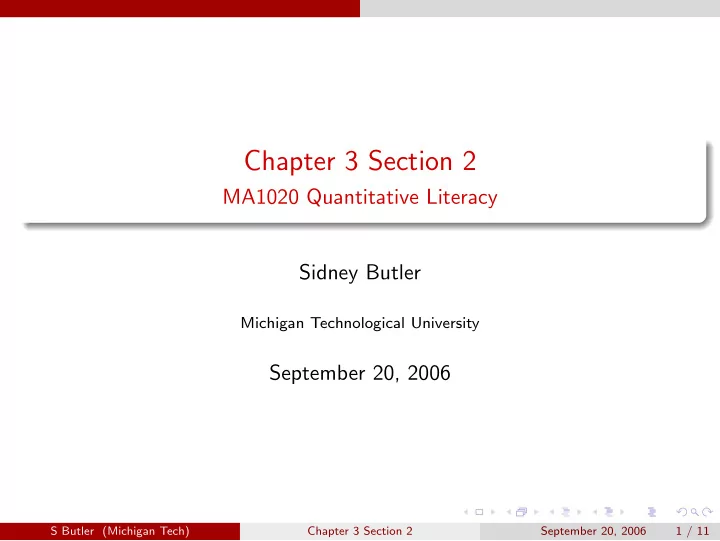

Chapter 3 Section 2 MA1020 Quantitative Literacy Sidney Butler Michigan Technological University September 20, 2006 S Butler (Michigan Tech) Chapter 3 Section 2 September 20, 2006 1 / 11
Fairness Criteria Majority Criterion Head-to-Head Criterion Monotonicity Criterion Irrelevant-Alternatives Criterion S Butler (Michigan Tech) Chapter 3 Section 2 September 20, 2006 2 / 11
Majority Criterion Definition If a candidate is the first choice of a majority of voters, then that candidate should be selected. S Butler (Michigan Tech) Chapter 3 Section 2 September 20, 2006 3 / 11
Majority Criterion Example A national association of bicycle manufacturers is planning its annual trade show. The steering committee, which consists of nine members, is considering four cities for the event: Chicago (C), Phoenix (P), and Boston (B). S Butler (Michigan Tech) Chapter 3 Section 2 September 20, 2006 4 / 11
Head-to-Head Criterion Definition If a candidate is favored when compared separately with each of the other candidates, then the favored candidate should be elected. S Butler (Michigan Tech) Chapter 3 Section 2 September 20, 2006 5 / 11
Head-to-Head Criterion Example A seven-member accounting department is planning a retirement celebration for a fellow employee. Three options have been discussed: a catered mean at the office (C), a picnic and barbecue (P), and a restaurant dinner (R). S Butler (Michigan Tech) Chapter 3 Section 2 September 20, 2006 6 / 11
Monotonicity Criterion Example Forty-one elementary teachers in a local school district must choose between three candidates for union president: Akst (A), Bailey (B), and Chung (C). S Butler (Michigan Tech) Chapter 3 Section 2 September 20, 2006 7 / 11
Monotonicity Criterion Definition Suppose a particular candidate X , is selected in an election. If hypothetically, this election were to be held again and each voter who changes his or her preferences does so by switching the positions of X and the candidate of one position above X in that voter’s preference ranking, then the candidate X should still be selected. S Butler (Michigan Tech) Chapter 3 Section 2 September 20, 2006 8 / 11
Irrelevant-Alternatives Criterion Example A local book club with five active members is voting to decide which book to read next. Three book choices have been nominated: a mystery (M), a historical novel (H), and a science fiction fantasy (S). S Butler (Michigan Tech) Chapter 3 Section 2 September 20, 2006 9 / 11
Irrelevant-Alternatives Criterion Definition Suppose a particular alternative, X , is selected in an election. If, hypothetically, this election were to be held again, but with one or more of the unselected alternatives removed from consideration, then the alternative X should still be selected. S Butler (Michigan Tech) Chapter 3 Section 2 September 20, 2006 10 / 11
Arrow Impossibility Theorem S Butler (Michigan Tech) Chapter 3 Section 2 September 20, 2006 11 / 11
Approval Voting Definition Each voter votes for all the candidates he or sheet considers acceptable. The candidate with the greatest number of votes is selected. S Butler (Michigan Tech) Chapter 3 Section 2 September 20, 2006 12 / 11
Recommend
More recommend